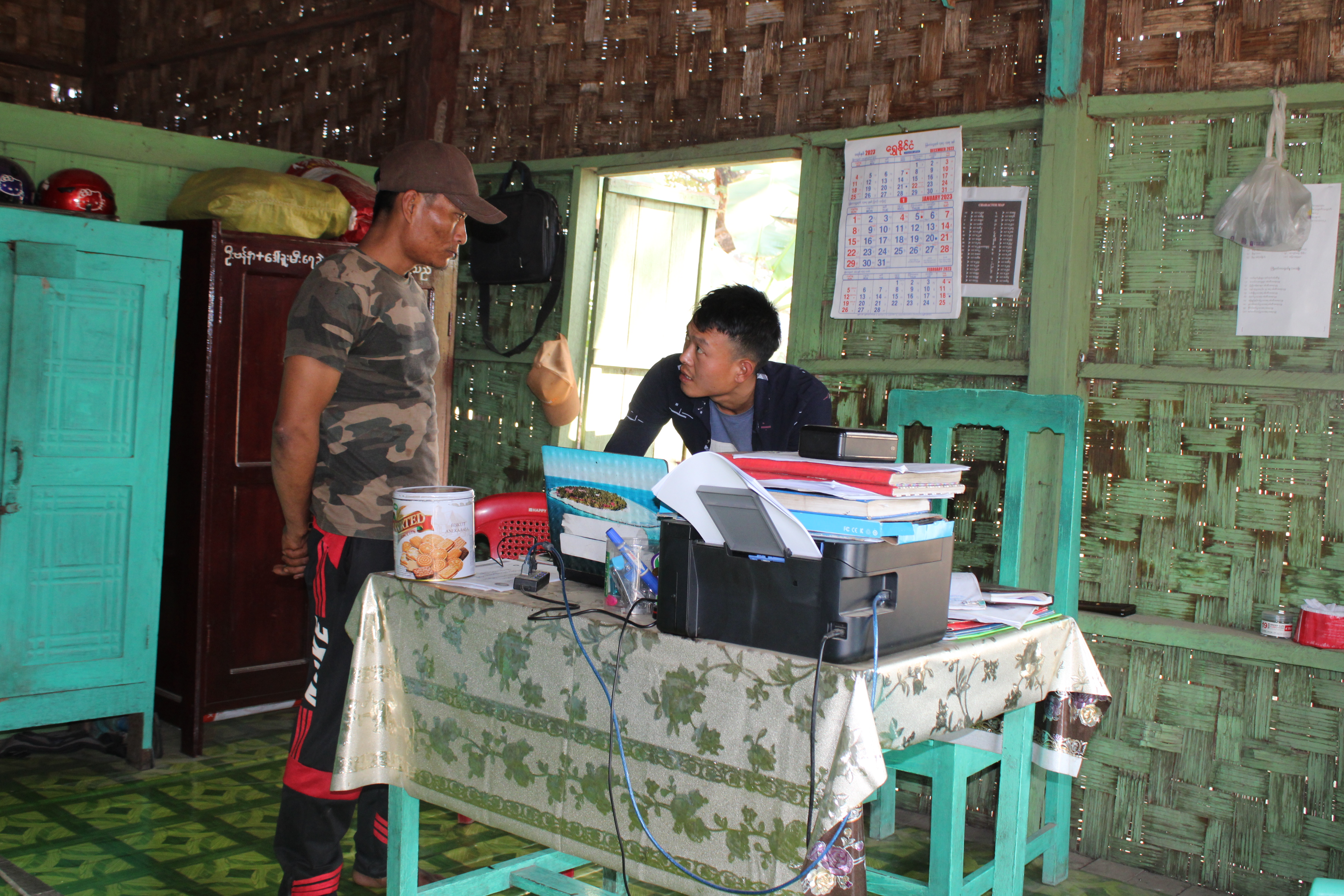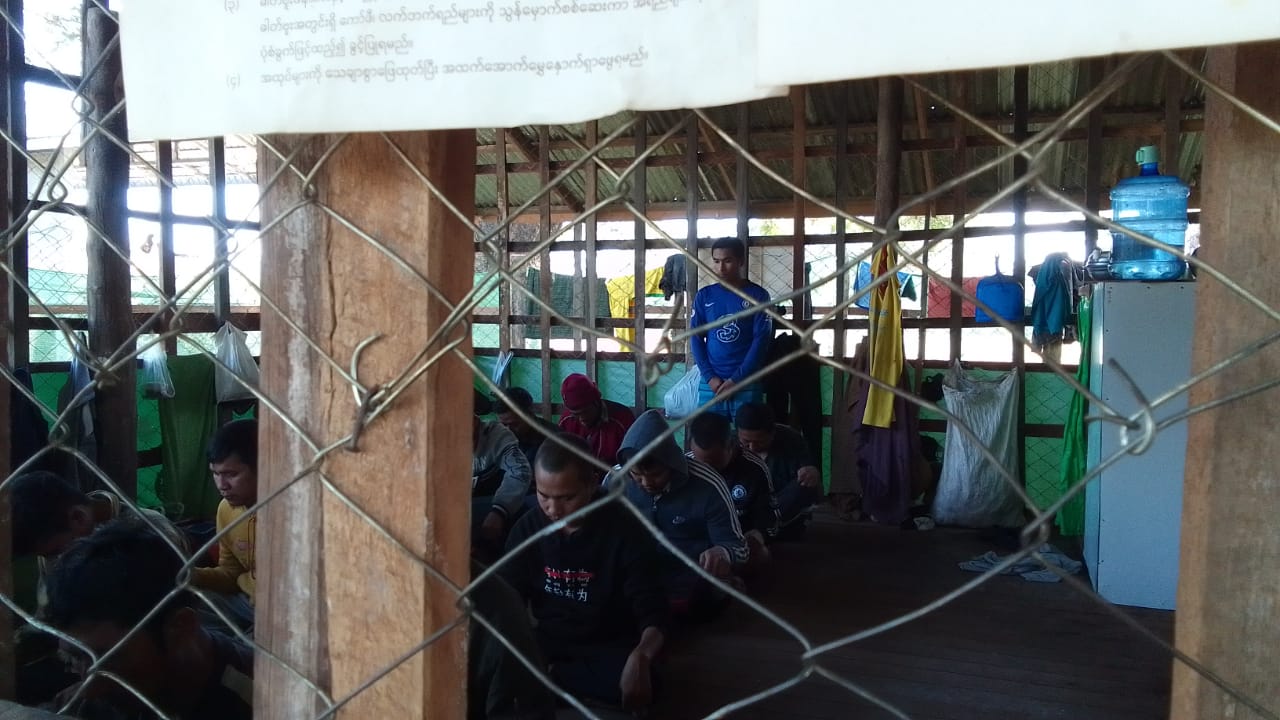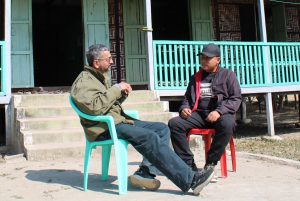North Kalay Police Station at Kalay in Myanmar’s Sagaing Region was among the first police stations to be established by the anti-junta resistance forces and recognized by the National Unity Government (NUG) after the February 2021 military coup in Myanmar. Pa Ka Pha, the local defense force in the region, began work on setting up a police station following a decision by the NUG early in October 2021 to set up a People’s Police under the Civil Disobedience Movement. The police station that existed at north Kalay near Letpanchaung, which functioned under the government before the coup, had been abandoned by police personnel after Kalay erupted in massive protests against the junta.
With the arrival of Han Thar Oo in early December 2021, the efforts of the Pa Ka Pha gathered momentum. Han Thar Oo, who hails from north Kalay, was a one-star police officer at Yangon when he decided to join the resistance movement after the coup. He is among the 2,937-odd police officers attached to the NUG — all of whom had joined the CDM after the coup. Resistance groups appointed him as head of the police in North Kalay and tasked him with establishing a system to check crime in the region.
In May of last year, police forces and stations under the NUG received a boost after the Committee Representing Pyidaungsu Hluttaw (Union Parliament), the legislative body of the NUG, enacted the People’s Police Force Law to regulate law enforcement in areas controlled by resistance forces.
On January 24, I visited the North Kalay Police Station near Letpanchaung. Similar to other stations, it is rudimentarily equipped and has a lock-up for criminals. But it is also different in that it is prepared for an attack from the regime forces. There are trenches around the police station and landmines have been manufactured for planting where necessary. Locations have been identified for police personnel to take positions as a defensive measure against junta attacks.
Here are excerpts from an interview with North Kalay Police Station chief Han Thar Oo.
Tell us about yourself.
I was born in Kalay. I joined the police service in 2013 as a one-star officer. I received training in Shan State at the Police Training Center for six months. I was posted there for two years and then transferred to Yangon, where I served for around a year. Our duty was mainly to patrol some parts of the city. This was stopped after the coup on February 1, 2021.
Subsequently, we were tasked with apprehending anti-coup protesters. We were instructed to shoot at them. I shot some protesters with rubber bullets. Then I realized that as a policeman my duty is to protect the people and not to shoot them. On March 5, I escaped from Yangon. Two of my friends from the police helped me escape. They took me to the taxi stand. I reached Mandalay and then Sagaing Region.

Inside the North Kalay Police Station, Jan. 24, 2023. Photo by Rajeev Bhattacharyya.
How many have left the police service like you?
Around 20,000 probably all over the country, but not everybody has registered with the CDM. This is almost double the number of army personnel who have left their jobs after the coup.
How did you get associated with this police station?
After arriving from Yangon, I was in hiding for almost two months at different locations in Sagaing Region. I realized I could not rest content with the CDM but wanted to engage against the military regime at a deeper level. At Chang-U in Sagaing Region, another policeman and I provided training to a batch of wannabe rebels, who were equipped with their own guns. But after the training ended, some members of this group were apprehended by the army. We then shifted the camp to another location very high on a hill. Then the group broke up.
Around May-June 2021, the Kalay PDF was formed. Meanwhile, some people who were trained by the Chin National Army at Camp Victoria in Chin State also returned to Sagaing Division. Then as the PDFs took shape and began to operate, I realized that a police service would be of huge importance if we were to set up our own government. I returned to Kalay. There was a high demand for the police in this region mainly because of drug trafficking and addiction. PDF and resistance leaders and a Member of Parliament from Kalay had also requested me to begin the police service.
On December 6, 2021, the Kalay Police Service was formed. It was a big challenge given the scant resources at our disposal. There is a constant danger of attacks from regime troops.
Prior to the coup, police here were not following the law. People had lost faith in the police because it was lax against criminals. Police were active mainly against the functionaries and sympathizers of the resistance movement. Many stations were attacked and burned in this region. There was lawlessness. The police service had collapsed. This police station was already abandoned before we occupied it. Some personnel had also joined the CDM.

A detention center at the north Kalay Police Station, January 24, 2023. Photo by Rajeev Bhattacharyya.
How has the police service been organized in North Kalay?
Before the coup, there were five police stations in Kalay, including the one in North Kalay. We moved here on March 3, 2022. The military has no presence here. I began with a team of 10 people, including myself; all of us had joined the CDM. Thirty-five more people were engaged with the station after training. Currently, our strength is 45 personnel. We remain in touch with the chief of the police service of the country, who is based at a secret location in Sagaing Region.
We have established two lock-ups – one in this police station and another in the jungle, where 17 and 21 people respectively are locked up. The NUG has recognized this police station. You can see the letter pasted on the wall of the station.
What is the area and population covered by this police station?
This station is responsible for the northern region of Kalay. There is a separate police station for the southern region. We cover about 50 villages, comprising around 50,000 people.
What are the challenging crimes that you deal with in Kalay?
The most challenging for us is checking drug trafficking. Drug trafficking has increased after the coup and the junta is involved in this illicit activity. A section of the military is compelled to get engaged because they do not receive regular salaries. The military’s objective is also to destroy the young generation through drugs. Consignments come mostly from Shan State. I have not heard of any place near Kalay where either Heroin No 4 or synthetic drugs are produced.
After the coup, 2,000 acres of poppy were planted at Tonzang in Chin State by farmers owing to poverty and lack of livelihood alternatives. There were some other places in and around Tedim where this phenomenon is discernible. Traffickers and consumers are from all income groups and include men and women.
Small packets are packed in soap boxes and then ferried across huge distances. Before the coup, the NLD government had made optimum efforts to curb the menace. Three sophisticated X-ray scanners were installed at three highways believed to be the main arteries of the drug trade to detect the consignments. On one occasion, drug barons attacked one of the X-ray scanners because it impeded the illicit trade. After the coup, the efforts have become lax. The scanners’ primary objective now is to detect weapons and not drugs.
Assassinations and killings have also emerged as a big challenge for us. Many dalans (informers of the military) have been killed on mere suspicion, on false information and without evidence. There were five cases of killings last year. In total, there were 96 cases of crime in the first year. This includes all types of cases. Drug trafficking accounted for most of the cases, followed by killings, theft, and rape.

North Kalay Police Chief Han Thar Oo with a seized consignment of drugs, Jan. 24, 2023. Credit: North Kalay Police
Almost every week there are seizures of drug consignments in India’s northeastern states. Are there cartels that have been specifically pushing drugs to India?
The export of drugs to India has certainly increased after the coup, which is very apparent from the quantity that has been confiscated in the last two years. It is the junta that is actively involved in drug trafficking, and there are people to ferry the consignments through numerous routes in the country. There is a wrong notion among some people that PDFs and refugees in India are involved in drug trafficking.
What happens to the criminals after they are arrested?
After they are arrested, a chargesheet is submitted to the court based on the investigation of the offense. Then, the accused is produced before the court. Currently, there are five courts with four judges. The verdict is binding on the police. The laws that are followed are mostly those that were in place under the earlier system before the coup, and some have been amended to suit the local conditions and situation.
How do you meet the expenses of the police station?
All personnel in the police station are volunteers. We do not take salaries. Expenses are met through local contributions and from the Pa Ka Pha.
How can the police administration be made more efficient? Are any plans being implemented?
We need more unity, support, a stable situation and effective expansion of our operations to more areas. Now we cannot go to the Pyu Hsaw Htee (allies of the military) villages, even if a serious offense or crime is committed there. If the junta decides to launch operations in this locality, then we would have to pack up and relocate to safer places. And in all probability, the station would be burned, and we will have to start all over again. Of course, we need more funds and manpower. Now very often we have to spend money from our pockets.
What kind of assistance have you received from the NUG?
Our police station is under the NUG’s Ministry of Home Affairs. Under the NUG, police services have been formed in only four districts so far, including Tamu and Wetlet. Kalay is among the first police stations recognized by the NUG. Guidelines and laws have been formulated by NUG. Police stations also function as per the norms laid down by the NUG. It is a process that has to grow and evolve.
There are so many guns everywhere with civilians in Myanmar. Imagine a situation when the military regime is toppled and democracy is restored in the country. Will so many weapons not trigger a serious law and order situation in the future?
In my personal opinion, it will be a very big challenge. But now, all the resistance groups have the same goals and are not much of a problem at the moment.
Could you deliver a message to the world from us?
I will, certainly.
This is an appeal to the world and especially to democratic nations. Myanmar is suffering. We appeal to the world not to forget us. Please assist us in our struggle against the atrocious junta. This must end once and for all.

































